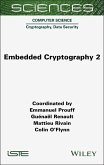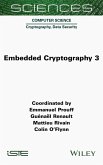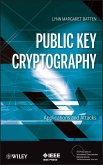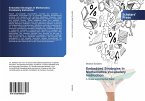- Gebundenes Buch
- Merkliste
- Auf die Merkliste
- Bewerten Bewerten
- Teilen
- Produkt teilen
- Produkterinnerung
- Produkterinnerung
Embedded Cryptography provides a comprehensive exploration of cryptographic techniques tailored for embedded systems, addressing the growing importance of security in devices such as mobile systems and IoT. The books explore the evolution of embedded cryptography since its inception in the mid-90s and cover both theoretical and practical aspects, as well as discussing the implementation of cryptographic algorithms such as AES, RSA, ECC and post-quantum algorithms. The work is structured into three volumes, spanning forty chapters and nine parts, and is enriched with pedagogical materials and…mehr
Andere Kunden interessierten sich auch für
![Embedded Cryptography 2 Embedded Cryptography 2]() Emmanuel ProuffEmbedded Cryptography 2146,99 €
Emmanuel ProuffEmbedded Cryptography 2146,99 €![Embedded Cryptography 3 Embedded Cryptography 3]() Emmanuel ProuffEmbedded Cryptography 3146,99 €
Emmanuel ProuffEmbedded Cryptography 3146,99 €![Cryptography, Information Theory, and Error-Correction Cryptography, Information Theory, and Error-Correction]() Aiden A. BruenCryptography, Information Theory, and Error-Correction130,99 €
Aiden A. BruenCryptography, Information Theory, and Error-Correction130,99 €![Topics in Geometry, Coding Theory and Cryptography Topics in Geometry, Coding Theory and Cryptography]() Arnaldo Garcia / Henning Stichtenoth (eds.)Topics in Geometry, Coding Theory and Cryptography38,99 €
Arnaldo Garcia / Henning Stichtenoth (eds.)Topics in Geometry, Coding Theory and Cryptography38,99 €![Quantum Communications and Cryptography Quantum Communications and Cryptography]() Quantum Communications and Cryptography63,99 €
Quantum Communications and Cryptography63,99 €![Public Key Cryptography Public Key Cryptography]() Lynn BattenPublic Key Cryptography83,99 €
Lynn BattenPublic Key Cryptography83,99 €![Embedded Strategies In Mathematics Vocabulary Instruction Embedded Strategies In Mathematics Vocabulary Instruction]() Sharon SandersEmbedded Strategies In Mathematics Vocabulary Instruction62,99 €
Sharon SandersEmbedded Strategies In Mathematics Vocabulary Instruction62,99 €-
-
-
Embedded Cryptography provides a comprehensive exploration of cryptographic techniques tailored for embedded systems, addressing the growing importance of security in devices such as mobile systems and IoT. The books explore the evolution of embedded cryptography since its inception in the mid-90s and cover both theoretical and practical aspects, as well as discussing the implementation of cryptographic algorithms such as AES, RSA, ECC and post-quantum algorithms. The work is structured into three volumes, spanning forty chapters and nine parts, and is enriched with pedagogical materials and real-world case studies, designed for researchers, professionals, and students alike, offering insights into both foundational and advanced topics in the field. Embedded Cryptography 1 is dedicated to software side-channel attacks, hardware side-channel attacks and fault injection attacks.
Produktdetails
- Produktdetails
- Verlag: Wiley
- Seitenzahl: 400
- Erscheinungstermin: 5. Februar 2025
- Englisch
- Abmessung: 239mm x 166mm x 27mm
- Gewicht: 712g
- ISBN-13: 9781789452136
- ISBN-10: 1789452139
- Artikelnr.: 72704427
- Herstellerkennzeichnung
- Libri GmbH
- Europaallee 1
- 36244 Bad Hersfeld
- gpsr@libri.de
- Verlag: Wiley
- Seitenzahl: 400
- Erscheinungstermin: 5. Februar 2025
- Englisch
- Abmessung: 239mm x 166mm x 27mm
- Gewicht: 712g
- ISBN-13: 9781789452136
- ISBN-10: 1789452139
- Artikelnr.: 72704427
- Herstellerkennzeichnung
- Libri GmbH
- Europaallee 1
- 36244 Bad Hersfeld
- gpsr@libri.de
Emmanuel Prouff is a researcher in Applied Cryptography and Embedded Security. He has worked as an expert for ANSSI, France, as well as for major security companies such as IDEMIA and SAFRAN, both to develop secure implementations against physical attacks. Guénaël Renault is Deputy Head of the Hardware Security Lab at ANSSI, France. His research interests include cryptography, algebraic (symbolic) computation and computational number theory. Mattieu Rivain is a researcher and entrepreneur in Cryptography, currently working as CEO at CryptoExperts, France. His research interests include provable security against side-channel attacks, white-box cryptography, zero-knowledge proofs and post-quantum signatures. Colin O'Flynn is Assistant Professor in Embedded Hardware Security at Dalhousie University, Canada. His interests include embedded hardware security, PCB design and prototype construction.
Preface xiii
Emmanuel PROUFF, Guénaël RENAULT, Matthieu RIVAIN and Colin O'FLYNN
Part 1 Software Side-Channel Attacks 1
Chapter 1 Timing Attacks 3
Daniel PAGE
1.1. Foundations 3
1.1.1. Execution latency in theory 4
1.1.2. Execution latency in practice 5
1.1.3. Attacks that exploit data-dependent execution latency 6
1.2. Example attacks 10
1.2.1. Example 1.1: an explanatory attack on password validation 10
1.2.2. Example 1.2: an attack on xtime-based AES 12
1.2.3. Example 1.3: an attack on Montgomery-based RSA 14
1.2.4. Example 1.4: a padding oracle attack on AES-CBC 17
1.3. Example mitigations 20
1.4. Notes and further references 21
1.5. References 24
Chapter 2 Microarchitectural Attacks 31
Yuval YAROM
2.1. Background 31
2.1.1. Memory caches 31
2.1.2. Cache hierarchies 32
2.1.3. Out-of-order execution 33
2.1.4. Branch prediction 34
2.1.5. Other caches 34
2.2. The Prime+Probe attack 34
2.2.1. Prime+Probe on the L1 data cache 35
2.2.2. Attacking T-table AES 36
2.2.3. Prime+probe on the LLC 38
2.2.4. Variants of Prime+Probe 39
2.3. The Flush+Reload attack 41
2.3.1. Attack technique 41
2.3.2. Attacking square-and-multiply exponentiation 42
2.3.3. Attack variants 43
2.3.4. Performance degradation attacks 44
2.4. Attacking other microarchitectural components 45
2.4.1. Instruction cache 45
2.4.2. Branch prediction 46
2.5. Constant-time programming 47
2.5.1. Constant-time select 47
2.5.2. Eliminating secret-dependent branches 48
2.5.3. Eliminating secret-dependent memory access 49
2.6. Covert channels 50
2.7. Transient-execution attacks 51
2.7.1. The Spectre attack 51
2.7.2. Meltdown-type attacks 53
2.8. Summary 54
2.9. Notes and further references 54
2.10. References 57
Part 2 Hardware Side-Channel Attacks 65
Chapter 3 Leakage and Attack Tools 67
Davide BELLIZIA and Adrian THILLARD
3.1. Introduction 67
3.2. Data-dependent physical emissions 67
3.2.1. Dynamic power 68
3.2.2. Static power 70
3.2.3. Electro-magnetic emissions 72
3.2.4. Other sources of physical leakages 73
3.3. Measuring a side-channel 75
3.3.1. Power analysis setup 75
3.3.2. Probes and probing methodologies 75
3.4. Leakage modeling 78
3.4.1. Mathematical modeling 78
3.4.2. Signal-to-noise ratio 81
3.4.3. Open source boards 83
3.4.4. Open source libraries for attacks 85
3.5. Notes and further references 86
3.6. References 87
Chapter 4 Supervised Attacks 91
Eleonora CAGLI and Loïc MASURE
4.1. General framework 91
4.1.1. The profiling ability: a powerful threat model 91
4.1.2. Maximum likelihood distinguisher 94
4.2. Building a model 98
4.2.1. Generative model via Gaussian templates 98
4.2.2. Discriminative model via logistic regression 100
4.2.3. From logistic regression to neural networks 102
4.3. Controlling the dimensionality 105
4.3.1. Points of interest selection with signal-to-noise ratio 106
4.3.2. Fisher's linear discriminant analysis 107
4.4. Building de-synchronization-resistant models 108
4.5. Summary of the chapter 112
4.6. Notes and further references 113
4.7. References 115
Chapter 5 Unsupervised Attacks 117
Cécile DUMAS
5.1. Introduction 117
5.1.1. Supervised attacks 117
5.1.2. Unsupervised attacks 118
5.1.3. How to attack without profiling? 120
5.2. Distinguishers 122
5.3. Likelihood distinguisher 123
5.3.1. Distinguisher definition 123
5.3.2. Determining Gaussian model parameters 125
5.3.3. Linear leakage model for sensitive data 125
5.3.4. Linear leakage model for sensitive data bits 127
5.3.5. Conclusion 128
5.4. Mutual information 129
5.4.1. Information theory 129
5.4.2. Distinguisher 131
5.4.3. Bijectivity 132
5.4.4. Probability calculation 133
5.4.5. Conclusion 135
5.5. Correlation 136
5.5.1. Linear relationship - CPA 136
5.5.2. Equivalence 138
5.5.3. Conclusion 139
5.6. A priori knowledge synthesis 139
5.7. Conclusion on statistical tools 142
5.8. Exercise solutions 144
5.9. Notes and further references 149
5.10. References 150
Chapter 6 Quantities to Judge Side Channel Resilience 153
Elisabeth OSWALD
6.1. Introduction 153
6.1.1. Assumptions and attack categories 154
6.1.2. Attack success 155
6.2. Metrics for comparing the effectiveness of specific attack vectors 156
6.2.1. Magnitude of scores 157
6.2.2. Number of needed leakage traces/success rate estimation 157
6.3. Metrics for evaluating the leakage (somewhat) independent of a
specific attack vector 158
6.3.1. Signal to noise ratio 158
6.3.2. Mutual information 159
6.4. Metrics for evaluating the remaining effort of an adversary 160
6.4.1. Key rank 160
6.4.2. Average key rank measures 161
6.4.3. Relationship with enumeration capabilities 162
6.5. Leakage detection as a radical alternative to attack driven
evaluations 162
6.6. Formal evaluation schemes 164
6.6.1. CC evaluations 165
6.6.2. Fips 140-3 166
6.6.3. Worst-case adversaries 167
6.7. References 167
Chapter 7 Countermeasures and Advanced Attacks 171
Brice COLOMBIER and Vincent GROSSO
7.1. Introduction 171
7.2. Misalignment of traces 173
7.2.1. Countermeasures 174
7.2.2. Attacks 179
7.3. Masking 180
7.3.1. Countermeasures 181
7.3.2. Attacks 182
7.4. Combination of countermeasures 183
7.5. To go further 184
7.6. References 185
Chapter 8 Mode-Level Side-Channel Countermeasures 187
Olivier PEREIRA, Thomas PETERS and François-Xavier STANDAERT
8.1. Introduction 187
8.2. Building blocks 188
8.3. Security definitions 190
8.3.1. Authenticated encryption and leakage 191
8.3.2. Integrity with leakage 192
8.3.3. Confidentiality with leakage 193
8.3.4. Discussion 195
8.4. Leakage models 197
8.4.1. Models for integrity 198
8.4.2. Models for confidentiality 199
8.4.3. Practical guidelines 201
8.5. Constructions 201
8.5.1. A leakage-resilient MAC 201
8.5.2. A leakage-resistant encryption scheme 204
8.5.3. A leakage-resistant AE scheme 207
8.6. Acknowledgments 208
8.7. Notes and further references 208
8.8. References 210
Part 3 Fault Injection Attacks 213
Chapter 9 An Introduction to Fault Injection Attacks 215
Jean-Max DUTERTRE and Jessy CLÉDIÈRE
9.1. Fault injection attacks, disturbance of electronic components 216
9.1.1. History of integrated circuit disturbance 216
9.1.2. Fault injection mechanisms 219
9.1.3. Fault injection benches 245
9.1.4. Fault models and fault injection simulation 253
9.2. Practical examples of fault injection attacks 262
9.2.1. Introduction 262
9.2.2. 1997 light attack on a secure product when loading a DES key 263
9.2.3. Experimental examples of an attack on a PIN identification routine
265
9.3. Notes and further references 272
9.4. References 273
Chapter 10 Fault Attacks on Symmetric Cryptography 277
Debdeep MUKHOPADHYAY and Sayandeep SAHA
10.1. Introduction 277
10.2. Differential fault analysis 278
10.2.1. Block ciphers and fault models 278
10.2.2. DFA on AES: single-byte fault 281
10.2.3. DFA on AES: multiple-byte fault 284
10.2.4. DFA on AES: other rounds 285
10.2.5. DFA on AES: key schedule 285
10.2.6. DFA on other ciphers: general idea 286
10.3. Automation of DFA 286
10.3.1. ExpFault 287
10.4. DFA countermeasures: general idea and taxonomy 289
10.4.1. Detection countermeasures 290
10.4.2. Infective countermeasures 291
10.4.3. Instruction-level countermeasures 292
10.5. Advanced FA 292
10.5.1. Biased fault model 293
10.5.2. Statistical fault attack 293
10.5.3. Statistical ineffective fault attack 294
10.5.4. Fault template attacks 296
10.5.5. Persistent fault attacks 301
10.6. Leakage assessment in fault attacks 302
10.7. Chapter summary 305
10.8. Notes and further references 306
10.9. References 307
Chapter 11 Fault Attacks on Public-key Cryptographic Algorithms 311
Michael TUNSTALL and Guillaume BARBU
11.1. Introduction 311
11.2. Preliminaries 312
11.2.1. Rsa 312
11.2.2. Elliptic curve cryptography 314
11.3. Attacking the RSA using the Chinese remainder theorem 315
11.4. Attacking a modular exponentiation 316
11.5. Attacking the ECDSA 318
11.6. Other attack strategies 319
11.6.1. Safe errors 319
11.6.2. Statistical ineffective fault attacks 319
11.6.3. Lattice-based fault attacks 320
11.7. Countermeasures 321
11.7.1. Padding schemes 322
11.7.2. Verification, detection and infection 322
11.7.3. Attacks on countermeasures 323
11.8. Conclusion 324
11.9. Notes and further references 325
11.10. References 328
Chapter 12 Fault Countermeasures 333
Patrick SCHAUMONT and Richa SINGH
12.1. Anatomy of a fault attack 333
12.2. Understanding the attacker 334
12.2.1. Fault attacker objectives 334
12.2.2. Fault attacker means 335
12.3. Taxonomy of fault countermeasures 336
12.4. Fault countermeasure principles 337
12.4.1. Redundancy 337
12.4.2. Randomness 338
12.4.3. Detectors 339
12.4.4. Safe-error defense 339
12.5. Fault countermeasure examples 340
12.5.1. Algorithm level countermeasures 340
12.6. ISA level countermeasures 342
12.7. RTL-level countermeasures 343
12.8. Circuit-level countermeasures 343
12.9. Design automation of fault countermeasures 344
12.10. Notes and further references 345
12.11. References 348
List of Authors 355
Index 357
Summary of Volume 2 363
Summary of Volume 3 371
Emmanuel PROUFF, Guénaël RENAULT, Matthieu RIVAIN and Colin O'FLYNN
Part 1 Software Side-Channel Attacks 1
Chapter 1 Timing Attacks 3
Daniel PAGE
1.1. Foundations 3
1.1.1. Execution latency in theory 4
1.1.2. Execution latency in practice 5
1.1.3. Attacks that exploit data-dependent execution latency 6
1.2. Example attacks 10
1.2.1. Example 1.1: an explanatory attack on password validation 10
1.2.2. Example 1.2: an attack on xtime-based AES 12
1.2.3. Example 1.3: an attack on Montgomery-based RSA 14
1.2.4. Example 1.4: a padding oracle attack on AES-CBC 17
1.3. Example mitigations 20
1.4. Notes and further references 21
1.5. References 24
Chapter 2 Microarchitectural Attacks 31
Yuval YAROM
2.1. Background 31
2.1.1. Memory caches 31
2.1.2. Cache hierarchies 32
2.1.3. Out-of-order execution 33
2.1.4. Branch prediction 34
2.1.5. Other caches 34
2.2. The Prime+Probe attack 34
2.2.1. Prime+Probe on the L1 data cache 35
2.2.2. Attacking T-table AES 36
2.2.3. Prime+probe on the LLC 38
2.2.4. Variants of Prime+Probe 39
2.3. The Flush+Reload attack 41
2.3.1. Attack technique 41
2.3.2. Attacking square-and-multiply exponentiation 42
2.3.3. Attack variants 43
2.3.4. Performance degradation attacks 44
2.4. Attacking other microarchitectural components 45
2.4.1. Instruction cache 45
2.4.2. Branch prediction 46
2.5. Constant-time programming 47
2.5.1. Constant-time select 47
2.5.2. Eliminating secret-dependent branches 48
2.5.3. Eliminating secret-dependent memory access 49
2.6. Covert channels 50
2.7. Transient-execution attacks 51
2.7.1. The Spectre attack 51
2.7.2. Meltdown-type attacks 53
2.8. Summary 54
2.9. Notes and further references 54
2.10. References 57
Part 2 Hardware Side-Channel Attacks 65
Chapter 3 Leakage and Attack Tools 67
Davide BELLIZIA and Adrian THILLARD
3.1. Introduction 67
3.2. Data-dependent physical emissions 67
3.2.1. Dynamic power 68
3.2.2. Static power 70
3.2.3. Electro-magnetic emissions 72
3.2.4. Other sources of physical leakages 73
3.3. Measuring a side-channel 75
3.3.1. Power analysis setup 75
3.3.2. Probes and probing methodologies 75
3.4. Leakage modeling 78
3.4.1. Mathematical modeling 78
3.4.2. Signal-to-noise ratio 81
3.4.3. Open source boards 83
3.4.4. Open source libraries for attacks 85
3.5. Notes and further references 86
3.6. References 87
Chapter 4 Supervised Attacks 91
Eleonora CAGLI and Loïc MASURE
4.1. General framework 91
4.1.1. The profiling ability: a powerful threat model 91
4.1.2. Maximum likelihood distinguisher 94
4.2. Building a model 98
4.2.1. Generative model via Gaussian templates 98
4.2.2. Discriminative model via logistic regression 100
4.2.3. From logistic regression to neural networks 102
4.3. Controlling the dimensionality 105
4.3.1. Points of interest selection with signal-to-noise ratio 106
4.3.2. Fisher's linear discriminant analysis 107
4.4. Building de-synchronization-resistant models 108
4.5. Summary of the chapter 112
4.6. Notes and further references 113
4.7. References 115
Chapter 5 Unsupervised Attacks 117
Cécile DUMAS
5.1. Introduction 117
5.1.1. Supervised attacks 117
5.1.2. Unsupervised attacks 118
5.1.3. How to attack without profiling? 120
5.2. Distinguishers 122
5.3. Likelihood distinguisher 123
5.3.1. Distinguisher definition 123
5.3.2. Determining Gaussian model parameters 125
5.3.3. Linear leakage model for sensitive data 125
5.3.4. Linear leakage model for sensitive data bits 127
5.3.5. Conclusion 128
5.4. Mutual information 129
5.4.1. Information theory 129
5.4.2. Distinguisher 131
5.4.3. Bijectivity 132
5.4.4. Probability calculation 133
5.4.5. Conclusion 135
5.5. Correlation 136
5.5.1. Linear relationship - CPA 136
5.5.2. Equivalence 138
5.5.3. Conclusion 139
5.6. A priori knowledge synthesis 139
5.7. Conclusion on statistical tools 142
5.8. Exercise solutions 144
5.9. Notes and further references 149
5.10. References 150
Chapter 6 Quantities to Judge Side Channel Resilience 153
Elisabeth OSWALD
6.1. Introduction 153
6.1.1. Assumptions and attack categories 154
6.1.2. Attack success 155
6.2. Metrics for comparing the effectiveness of specific attack vectors 156
6.2.1. Magnitude of scores 157
6.2.2. Number of needed leakage traces/success rate estimation 157
6.3. Metrics for evaluating the leakage (somewhat) independent of a
specific attack vector 158
6.3.1. Signal to noise ratio 158
6.3.2. Mutual information 159
6.4. Metrics for evaluating the remaining effort of an adversary 160
6.4.1. Key rank 160
6.4.2. Average key rank measures 161
6.4.3. Relationship with enumeration capabilities 162
6.5. Leakage detection as a radical alternative to attack driven
evaluations 162
6.6. Formal evaluation schemes 164
6.6.1. CC evaluations 165
6.6.2. Fips 140-3 166
6.6.3. Worst-case adversaries 167
6.7. References 167
Chapter 7 Countermeasures and Advanced Attacks 171
Brice COLOMBIER and Vincent GROSSO
7.1. Introduction 171
7.2. Misalignment of traces 173
7.2.1. Countermeasures 174
7.2.2. Attacks 179
7.3. Masking 180
7.3.1. Countermeasures 181
7.3.2. Attacks 182
7.4. Combination of countermeasures 183
7.5. To go further 184
7.6. References 185
Chapter 8 Mode-Level Side-Channel Countermeasures 187
Olivier PEREIRA, Thomas PETERS and François-Xavier STANDAERT
8.1. Introduction 187
8.2. Building blocks 188
8.3. Security definitions 190
8.3.1. Authenticated encryption and leakage 191
8.3.2. Integrity with leakage 192
8.3.3. Confidentiality with leakage 193
8.3.4. Discussion 195
8.4. Leakage models 197
8.4.1. Models for integrity 198
8.4.2. Models for confidentiality 199
8.4.3. Practical guidelines 201
8.5. Constructions 201
8.5.1. A leakage-resilient MAC 201
8.5.2. A leakage-resistant encryption scheme 204
8.5.3. A leakage-resistant AE scheme 207
8.6. Acknowledgments 208
8.7. Notes and further references 208
8.8. References 210
Part 3 Fault Injection Attacks 213
Chapter 9 An Introduction to Fault Injection Attacks 215
Jean-Max DUTERTRE and Jessy CLÉDIÈRE
9.1. Fault injection attacks, disturbance of electronic components 216
9.1.1. History of integrated circuit disturbance 216
9.1.2. Fault injection mechanisms 219
9.1.3. Fault injection benches 245
9.1.4. Fault models and fault injection simulation 253
9.2. Practical examples of fault injection attacks 262
9.2.1. Introduction 262
9.2.2. 1997 light attack on a secure product when loading a DES key 263
9.2.3. Experimental examples of an attack on a PIN identification routine
265
9.3. Notes and further references 272
9.4. References 273
Chapter 10 Fault Attacks on Symmetric Cryptography 277
Debdeep MUKHOPADHYAY and Sayandeep SAHA
10.1. Introduction 277
10.2. Differential fault analysis 278
10.2.1. Block ciphers and fault models 278
10.2.2. DFA on AES: single-byte fault 281
10.2.3. DFA on AES: multiple-byte fault 284
10.2.4. DFA on AES: other rounds 285
10.2.5. DFA on AES: key schedule 285
10.2.6. DFA on other ciphers: general idea 286
10.3. Automation of DFA 286
10.3.1. ExpFault 287
10.4. DFA countermeasures: general idea and taxonomy 289
10.4.1. Detection countermeasures 290
10.4.2. Infective countermeasures 291
10.4.3. Instruction-level countermeasures 292
10.5. Advanced FA 292
10.5.1. Biased fault model 293
10.5.2. Statistical fault attack 293
10.5.3. Statistical ineffective fault attack 294
10.5.4. Fault template attacks 296
10.5.5. Persistent fault attacks 301
10.6. Leakage assessment in fault attacks 302
10.7. Chapter summary 305
10.8. Notes and further references 306
10.9. References 307
Chapter 11 Fault Attacks on Public-key Cryptographic Algorithms 311
Michael TUNSTALL and Guillaume BARBU
11.1. Introduction 311
11.2. Preliminaries 312
11.2.1. Rsa 312
11.2.2. Elliptic curve cryptography 314
11.3. Attacking the RSA using the Chinese remainder theorem 315
11.4. Attacking a modular exponentiation 316
11.5. Attacking the ECDSA 318
11.6. Other attack strategies 319
11.6.1. Safe errors 319
11.6.2. Statistical ineffective fault attacks 319
11.6.3. Lattice-based fault attacks 320
11.7. Countermeasures 321
11.7.1. Padding schemes 322
11.7.2. Verification, detection and infection 322
11.7.3. Attacks on countermeasures 323
11.8. Conclusion 324
11.9. Notes and further references 325
11.10. References 328
Chapter 12 Fault Countermeasures 333
Patrick SCHAUMONT and Richa SINGH
12.1. Anatomy of a fault attack 333
12.2. Understanding the attacker 334
12.2.1. Fault attacker objectives 334
12.2.2. Fault attacker means 335
12.3. Taxonomy of fault countermeasures 336
12.4. Fault countermeasure principles 337
12.4.1. Redundancy 337
12.4.2. Randomness 338
12.4.3. Detectors 339
12.4.4. Safe-error defense 339
12.5. Fault countermeasure examples 340
12.5.1. Algorithm level countermeasures 340
12.6. ISA level countermeasures 342
12.7. RTL-level countermeasures 343
12.8. Circuit-level countermeasures 343
12.9. Design automation of fault countermeasures 344
12.10. Notes and further references 345
12.11. References 348
List of Authors 355
Index 357
Summary of Volume 2 363
Summary of Volume 3 371
Preface xiii
Emmanuel PROUFF, Guénaël RENAULT, Matthieu RIVAIN and Colin O'FLYNN
Part 1 Software Side-Channel Attacks 1
Chapter 1 Timing Attacks 3
Daniel PAGE
1.1. Foundations 3
1.1.1. Execution latency in theory 4
1.1.2. Execution latency in practice 5
1.1.3. Attacks that exploit data-dependent execution latency 6
1.2. Example attacks 10
1.2.1. Example 1.1: an explanatory attack on password validation 10
1.2.2. Example 1.2: an attack on xtime-based AES 12
1.2.3. Example 1.3: an attack on Montgomery-based RSA 14
1.2.4. Example 1.4: a padding oracle attack on AES-CBC 17
1.3. Example mitigations 20
1.4. Notes and further references 21
1.5. References 24
Chapter 2 Microarchitectural Attacks 31
Yuval YAROM
2.1. Background 31
2.1.1. Memory caches 31
2.1.2. Cache hierarchies 32
2.1.3. Out-of-order execution 33
2.1.4. Branch prediction 34
2.1.5. Other caches 34
2.2. The Prime+Probe attack 34
2.2.1. Prime+Probe on the L1 data cache 35
2.2.2. Attacking T-table AES 36
2.2.3. Prime+probe on the LLC 38
2.2.4. Variants of Prime+Probe 39
2.3. The Flush+Reload attack 41
2.3.1. Attack technique 41
2.3.2. Attacking square-and-multiply exponentiation 42
2.3.3. Attack variants 43
2.3.4. Performance degradation attacks 44
2.4. Attacking other microarchitectural components 45
2.4.1. Instruction cache 45
2.4.2. Branch prediction 46
2.5. Constant-time programming 47
2.5.1. Constant-time select 47
2.5.2. Eliminating secret-dependent branches 48
2.5.3. Eliminating secret-dependent memory access 49
2.6. Covert channels 50
2.7. Transient-execution attacks 51
2.7.1. The Spectre attack 51
2.7.2. Meltdown-type attacks 53
2.8. Summary 54
2.9. Notes and further references 54
2.10. References 57
Part 2 Hardware Side-Channel Attacks 65
Chapter 3 Leakage and Attack Tools 67
Davide BELLIZIA and Adrian THILLARD
3.1. Introduction 67
3.2. Data-dependent physical emissions 67
3.2.1. Dynamic power 68
3.2.2. Static power 70
3.2.3. Electro-magnetic emissions 72
3.2.4. Other sources of physical leakages 73
3.3. Measuring a side-channel 75
3.3.1. Power analysis setup 75
3.3.2. Probes and probing methodologies 75
3.4. Leakage modeling 78
3.4.1. Mathematical modeling 78
3.4.2. Signal-to-noise ratio 81
3.4.3. Open source boards 83
3.4.4. Open source libraries for attacks 85
3.5. Notes and further references 86
3.6. References 87
Chapter 4 Supervised Attacks 91
Eleonora CAGLI and Loïc MASURE
4.1. General framework 91
4.1.1. The profiling ability: a powerful threat model 91
4.1.2. Maximum likelihood distinguisher 94
4.2. Building a model 98
4.2.1. Generative model via Gaussian templates 98
4.2.2. Discriminative model via logistic regression 100
4.2.3. From logistic regression to neural networks 102
4.3. Controlling the dimensionality 105
4.3.1. Points of interest selection with signal-to-noise ratio 106
4.3.2. Fisher's linear discriminant analysis 107
4.4. Building de-synchronization-resistant models 108
4.5. Summary of the chapter 112
4.6. Notes and further references 113
4.7. References 115
Chapter 5 Unsupervised Attacks 117
Cécile DUMAS
5.1. Introduction 117
5.1.1. Supervised attacks 117
5.1.2. Unsupervised attacks 118
5.1.3. How to attack without profiling? 120
5.2. Distinguishers 122
5.3. Likelihood distinguisher 123
5.3.1. Distinguisher definition 123
5.3.2. Determining Gaussian model parameters 125
5.3.3. Linear leakage model for sensitive data 125
5.3.4. Linear leakage model for sensitive data bits 127
5.3.5. Conclusion 128
5.4. Mutual information 129
5.4.1. Information theory 129
5.4.2. Distinguisher 131
5.4.3. Bijectivity 132
5.4.4. Probability calculation 133
5.4.5. Conclusion 135
5.5. Correlation 136
5.5.1. Linear relationship - CPA 136
5.5.2. Equivalence 138
5.5.3. Conclusion 139
5.6. A priori knowledge synthesis 139
5.7. Conclusion on statistical tools 142
5.8. Exercise solutions 144
5.9. Notes and further references 149
5.10. References 150
Chapter 6 Quantities to Judge Side Channel Resilience 153
Elisabeth OSWALD
6.1. Introduction 153
6.1.1. Assumptions and attack categories 154
6.1.2. Attack success 155
6.2. Metrics for comparing the effectiveness of specific attack vectors 156
6.2.1. Magnitude of scores 157
6.2.2. Number of needed leakage traces/success rate estimation 157
6.3. Metrics for evaluating the leakage (somewhat) independent of a
specific attack vector 158
6.3.1. Signal to noise ratio 158
6.3.2. Mutual information 159
6.4. Metrics for evaluating the remaining effort of an adversary 160
6.4.1. Key rank 160
6.4.2. Average key rank measures 161
6.4.3. Relationship with enumeration capabilities 162
6.5. Leakage detection as a radical alternative to attack driven
evaluations 162
6.6. Formal evaluation schemes 164
6.6.1. CC evaluations 165
6.6.2. Fips 140-3 166
6.6.3. Worst-case adversaries 167
6.7. References 167
Chapter 7 Countermeasures and Advanced Attacks 171
Brice COLOMBIER and Vincent GROSSO
7.1. Introduction 171
7.2. Misalignment of traces 173
7.2.1. Countermeasures 174
7.2.2. Attacks 179
7.3. Masking 180
7.3.1. Countermeasures 181
7.3.2. Attacks 182
7.4. Combination of countermeasures 183
7.5. To go further 184
7.6. References 185
Chapter 8 Mode-Level Side-Channel Countermeasures 187
Olivier PEREIRA, Thomas PETERS and François-Xavier STANDAERT
8.1. Introduction 187
8.2. Building blocks 188
8.3. Security definitions 190
8.3.1. Authenticated encryption and leakage 191
8.3.2. Integrity with leakage 192
8.3.3. Confidentiality with leakage 193
8.3.4. Discussion 195
8.4. Leakage models 197
8.4.1. Models for integrity 198
8.4.2. Models for confidentiality 199
8.4.3. Practical guidelines 201
8.5. Constructions 201
8.5.1. A leakage-resilient MAC 201
8.5.2. A leakage-resistant encryption scheme 204
8.5.3. A leakage-resistant AE scheme 207
8.6. Acknowledgments 208
8.7. Notes and further references 208
8.8. References 210
Part 3 Fault Injection Attacks 213
Chapter 9 An Introduction to Fault Injection Attacks 215
Jean-Max DUTERTRE and Jessy CLÉDIÈRE
9.1. Fault injection attacks, disturbance of electronic components 216
9.1.1. History of integrated circuit disturbance 216
9.1.2. Fault injection mechanisms 219
9.1.3. Fault injection benches 245
9.1.4. Fault models and fault injection simulation 253
9.2. Practical examples of fault injection attacks 262
9.2.1. Introduction 262
9.2.2. 1997 light attack on a secure product when loading a DES key 263
9.2.3. Experimental examples of an attack on a PIN identification routine
265
9.3. Notes and further references 272
9.4. References 273
Chapter 10 Fault Attacks on Symmetric Cryptography 277
Debdeep MUKHOPADHYAY and Sayandeep SAHA
10.1. Introduction 277
10.2. Differential fault analysis 278
10.2.1. Block ciphers and fault models 278
10.2.2. DFA on AES: single-byte fault 281
10.2.3. DFA on AES: multiple-byte fault 284
10.2.4. DFA on AES: other rounds 285
10.2.5. DFA on AES: key schedule 285
10.2.6. DFA on other ciphers: general idea 286
10.3. Automation of DFA 286
10.3.1. ExpFault 287
10.4. DFA countermeasures: general idea and taxonomy 289
10.4.1. Detection countermeasures 290
10.4.2. Infective countermeasures 291
10.4.3. Instruction-level countermeasures 292
10.5. Advanced FA 292
10.5.1. Biased fault model 293
10.5.2. Statistical fault attack 293
10.5.3. Statistical ineffective fault attack 294
10.5.4. Fault template attacks 296
10.5.5. Persistent fault attacks 301
10.6. Leakage assessment in fault attacks 302
10.7. Chapter summary 305
10.8. Notes and further references 306
10.9. References 307
Chapter 11 Fault Attacks on Public-key Cryptographic Algorithms 311
Michael TUNSTALL and Guillaume BARBU
11.1. Introduction 311
11.2. Preliminaries 312
11.2.1. Rsa 312
11.2.2. Elliptic curve cryptography 314
11.3. Attacking the RSA using the Chinese remainder theorem 315
11.4. Attacking a modular exponentiation 316
11.5. Attacking the ECDSA 318
11.6. Other attack strategies 319
11.6.1. Safe errors 319
11.6.2. Statistical ineffective fault attacks 319
11.6.3. Lattice-based fault attacks 320
11.7. Countermeasures 321
11.7.1. Padding schemes 322
11.7.2. Verification, detection and infection 322
11.7.3. Attacks on countermeasures 323
11.8. Conclusion 324
11.9. Notes and further references 325
11.10. References 328
Chapter 12 Fault Countermeasures 333
Patrick SCHAUMONT and Richa SINGH
12.1. Anatomy of a fault attack 333
12.2. Understanding the attacker 334
12.2.1. Fault attacker objectives 334
12.2.2. Fault attacker means 335
12.3. Taxonomy of fault countermeasures 336
12.4. Fault countermeasure principles 337
12.4.1. Redundancy 337
12.4.2. Randomness 338
12.4.3. Detectors 339
12.4.4. Safe-error defense 339
12.5. Fault countermeasure examples 340
12.5.1. Algorithm level countermeasures 340
12.6. ISA level countermeasures 342
12.7. RTL-level countermeasures 343
12.8. Circuit-level countermeasures 343
12.9. Design automation of fault countermeasures 344
12.10. Notes and further references 345
12.11. References 348
List of Authors 355
Index 357
Summary of Volume 2 363
Summary of Volume 3 371
Emmanuel PROUFF, Guénaël RENAULT, Matthieu RIVAIN and Colin O'FLYNN
Part 1 Software Side-Channel Attacks 1
Chapter 1 Timing Attacks 3
Daniel PAGE
1.1. Foundations 3
1.1.1. Execution latency in theory 4
1.1.2. Execution latency in practice 5
1.1.3. Attacks that exploit data-dependent execution latency 6
1.2. Example attacks 10
1.2.1. Example 1.1: an explanatory attack on password validation 10
1.2.2. Example 1.2: an attack on xtime-based AES 12
1.2.3. Example 1.3: an attack on Montgomery-based RSA 14
1.2.4. Example 1.4: a padding oracle attack on AES-CBC 17
1.3. Example mitigations 20
1.4. Notes and further references 21
1.5. References 24
Chapter 2 Microarchitectural Attacks 31
Yuval YAROM
2.1. Background 31
2.1.1. Memory caches 31
2.1.2. Cache hierarchies 32
2.1.3. Out-of-order execution 33
2.1.4. Branch prediction 34
2.1.5. Other caches 34
2.2. The Prime+Probe attack 34
2.2.1. Prime+Probe on the L1 data cache 35
2.2.2. Attacking T-table AES 36
2.2.3. Prime+probe on the LLC 38
2.2.4. Variants of Prime+Probe 39
2.3. The Flush+Reload attack 41
2.3.1. Attack technique 41
2.3.2. Attacking square-and-multiply exponentiation 42
2.3.3. Attack variants 43
2.3.4. Performance degradation attacks 44
2.4. Attacking other microarchitectural components 45
2.4.1. Instruction cache 45
2.4.2. Branch prediction 46
2.5. Constant-time programming 47
2.5.1. Constant-time select 47
2.5.2. Eliminating secret-dependent branches 48
2.5.3. Eliminating secret-dependent memory access 49
2.6. Covert channels 50
2.7. Transient-execution attacks 51
2.7.1. The Spectre attack 51
2.7.2. Meltdown-type attacks 53
2.8. Summary 54
2.9. Notes and further references 54
2.10. References 57
Part 2 Hardware Side-Channel Attacks 65
Chapter 3 Leakage and Attack Tools 67
Davide BELLIZIA and Adrian THILLARD
3.1. Introduction 67
3.2. Data-dependent physical emissions 67
3.2.1. Dynamic power 68
3.2.2. Static power 70
3.2.3. Electro-magnetic emissions 72
3.2.4. Other sources of physical leakages 73
3.3. Measuring a side-channel 75
3.3.1. Power analysis setup 75
3.3.2. Probes and probing methodologies 75
3.4. Leakage modeling 78
3.4.1. Mathematical modeling 78
3.4.2. Signal-to-noise ratio 81
3.4.3. Open source boards 83
3.4.4. Open source libraries for attacks 85
3.5. Notes and further references 86
3.6. References 87
Chapter 4 Supervised Attacks 91
Eleonora CAGLI and Loïc MASURE
4.1. General framework 91
4.1.1. The profiling ability: a powerful threat model 91
4.1.2. Maximum likelihood distinguisher 94
4.2. Building a model 98
4.2.1. Generative model via Gaussian templates 98
4.2.2. Discriminative model via logistic regression 100
4.2.3. From logistic regression to neural networks 102
4.3. Controlling the dimensionality 105
4.3.1. Points of interest selection with signal-to-noise ratio 106
4.3.2. Fisher's linear discriminant analysis 107
4.4. Building de-synchronization-resistant models 108
4.5. Summary of the chapter 112
4.6. Notes and further references 113
4.7. References 115
Chapter 5 Unsupervised Attacks 117
Cécile DUMAS
5.1. Introduction 117
5.1.1. Supervised attacks 117
5.1.2. Unsupervised attacks 118
5.1.3. How to attack without profiling? 120
5.2. Distinguishers 122
5.3. Likelihood distinguisher 123
5.3.1. Distinguisher definition 123
5.3.2. Determining Gaussian model parameters 125
5.3.3. Linear leakage model for sensitive data 125
5.3.4. Linear leakage model for sensitive data bits 127
5.3.5. Conclusion 128
5.4. Mutual information 129
5.4.1. Information theory 129
5.4.2. Distinguisher 131
5.4.3. Bijectivity 132
5.4.4. Probability calculation 133
5.4.5. Conclusion 135
5.5. Correlation 136
5.5.1. Linear relationship - CPA 136
5.5.2. Equivalence 138
5.5.3. Conclusion 139
5.6. A priori knowledge synthesis 139
5.7. Conclusion on statistical tools 142
5.8. Exercise solutions 144
5.9. Notes and further references 149
5.10. References 150
Chapter 6 Quantities to Judge Side Channel Resilience 153
Elisabeth OSWALD
6.1. Introduction 153
6.1.1. Assumptions and attack categories 154
6.1.2. Attack success 155
6.2. Metrics for comparing the effectiveness of specific attack vectors 156
6.2.1. Magnitude of scores 157
6.2.2. Number of needed leakage traces/success rate estimation 157
6.3. Metrics for evaluating the leakage (somewhat) independent of a
specific attack vector 158
6.3.1. Signal to noise ratio 158
6.3.2. Mutual information 159
6.4. Metrics for evaluating the remaining effort of an adversary 160
6.4.1. Key rank 160
6.4.2. Average key rank measures 161
6.4.3. Relationship with enumeration capabilities 162
6.5. Leakage detection as a radical alternative to attack driven
evaluations 162
6.6. Formal evaluation schemes 164
6.6.1. CC evaluations 165
6.6.2. Fips 140-3 166
6.6.3. Worst-case adversaries 167
6.7. References 167
Chapter 7 Countermeasures and Advanced Attacks 171
Brice COLOMBIER and Vincent GROSSO
7.1. Introduction 171
7.2. Misalignment of traces 173
7.2.1. Countermeasures 174
7.2.2. Attacks 179
7.3. Masking 180
7.3.1. Countermeasures 181
7.3.2. Attacks 182
7.4. Combination of countermeasures 183
7.5. To go further 184
7.6. References 185
Chapter 8 Mode-Level Side-Channel Countermeasures 187
Olivier PEREIRA, Thomas PETERS and François-Xavier STANDAERT
8.1. Introduction 187
8.2. Building blocks 188
8.3. Security definitions 190
8.3.1. Authenticated encryption and leakage 191
8.3.2. Integrity with leakage 192
8.3.3. Confidentiality with leakage 193
8.3.4. Discussion 195
8.4. Leakage models 197
8.4.1. Models for integrity 198
8.4.2. Models for confidentiality 199
8.4.3. Practical guidelines 201
8.5. Constructions 201
8.5.1. A leakage-resilient MAC 201
8.5.2. A leakage-resistant encryption scheme 204
8.5.3. A leakage-resistant AE scheme 207
8.6. Acknowledgments 208
8.7. Notes and further references 208
8.8. References 210
Part 3 Fault Injection Attacks 213
Chapter 9 An Introduction to Fault Injection Attacks 215
Jean-Max DUTERTRE and Jessy CLÉDIÈRE
9.1. Fault injection attacks, disturbance of electronic components 216
9.1.1. History of integrated circuit disturbance 216
9.1.2. Fault injection mechanisms 219
9.1.3. Fault injection benches 245
9.1.4. Fault models and fault injection simulation 253
9.2. Practical examples of fault injection attacks 262
9.2.1. Introduction 262
9.2.2. 1997 light attack on a secure product when loading a DES key 263
9.2.3. Experimental examples of an attack on a PIN identification routine
265
9.3. Notes and further references 272
9.4. References 273
Chapter 10 Fault Attacks on Symmetric Cryptography 277
Debdeep MUKHOPADHYAY and Sayandeep SAHA
10.1. Introduction 277
10.2. Differential fault analysis 278
10.2.1. Block ciphers and fault models 278
10.2.2. DFA on AES: single-byte fault 281
10.2.3. DFA on AES: multiple-byte fault 284
10.2.4. DFA on AES: other rounds 285
10.2.5. DFA on AES: key schedule 285
10.2.6. DFA on other ciphers: general idea 286
10.3. Automation of DFA 286
10.3.1. ExpFault 287
10.4. DFA countermeasures: general idea and taxonomy 289
10.4.1. Detection countermeasures 290
10.4.2. Infective countermeasures 291
10.4.3. Instruction-level countermeasures 292
10.5. Advanced FA 292
10.5.1. Biased fault model 293
10.5.2. Statistical fault attack 293
10.5.3. Statistical ineffective fault attack 294
10.5.4. Fault template attacks 296
10.5.5. Persistent fault attacks 301
10.6. Leakage assessment in fault attacks 302
10.7. Chapter summary 305
10.8. Notes and further references 306
10.9. References 307
Chapter 11 Fault Attacks on Public-key Cryptographic Algorithms 311
Michael TUNSTALL and Guillaume BARBU
11.1. Introduction 311
11.2. Preliminaries 312
11.2.1. Rsa 312
11.2.2. Elliptic curve cryptography 314
11.3. Attacking the RSA using the Chinese remainder theorem 315
11.4. Attacking a modular exponentiation 316
11.5. Attacking the ECDSA 318
11.6. Other attack strategies 319
11.6.1. Safe errors 319
11.6.2. Statistical ineffective fault attacks 319
11.6.3. Lattice-based fault attacks 320
11.7. Countermeasures 321
11.7.1. Padding schemes 322
11.7.2. Verification, detection and infection 322
11.7.3. Attacks on countermeasures 323
11.8. Conclusion 324
11.9. Notes and further references 325
11.10. References 328
Chapter 12 Fault Countermeasures 333
Patrick SCHAUMONT and Richa SINGH
12.1. Anatomy of a fault attack 333
12.2. Understanding the attacker 334
12.2.1. Fault attacker objectives 334
12.2.2. Fault attacker means 335
12.3. Taxonomy of fault countermeasures 336
12.4. Fault countermeasure principles 337
12.4.1. Redundancy 337
12.4.2. Randomness 338
12.4.3. Detectors 339
12.4.4. Safe-error defense 339
12.5. Fault countermeasure examples 340
12.5.1. Algorithm level countermeasures 340
12.6. ISA level countermeasures 342
12.7. RTL-level countermeasures 343
12.8. Circuit-level countermeasures 343
12.9. Design automation of fault countermeasures 344
12.10. Notes and further references 345
12.11. References 348
List of Authors 355
Index 357
Summary of Volume 2 363
Summary of Volume 3 371









